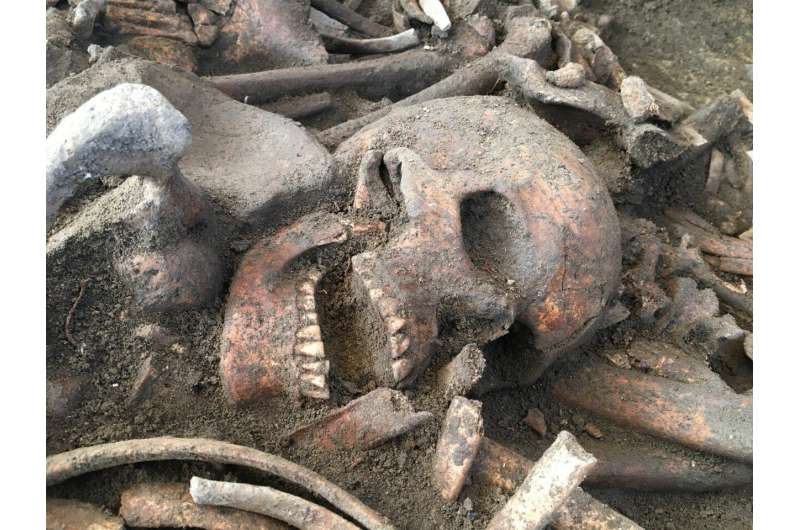New, almost non-destructive archaeogenetic sampling method developed

An Austrian-American research team (University of Vienna, Department Evolutionary Anthropology and Harvard Medical School, Department of Genetics), in collaboration of Hungarian experts from Eötvös Loránd University, has developed a new method that allows the almost non-destructive extraction of genetic material from archeological human remains. The method allows anthropologists, archeologists and archaeogeneticists to avoid the risk of serious damage to artifacts of significant scientific and heritage value, which can then be fully examined in future research.
Bioarcheological research on human and animal remains from archeological excavations has become increasingly important in recent decades. Both nationally and internationally, in addition to classical archeological and anthropological research, a significant number of molecular biological way of examination are included. One of the most important fields is archaeogenetics. The study of ancient human and animal genetic material can significantly help both the analysis of human evolution and the answering of historical questions about the populations of later archeological periods.
The first archaic DNA (aDNA) research started in the 1980s, but the real methodological breakthroughs came after the turn of the millennium. This was the period when next-generation sequencing methods reached bioarcheological research. Thanks to the large-scale research that began at that time, we now know more than 60% of the DNA of Neanderthals preserved in the nuclei of cells. A new human species was described on the basis of the genetic material extracted from teeth and finger bones found in Siberia, and it was recognized that, contrary to previous ideas, Neanderthal man and modern Homo sapiens interbred with each other, that left significant genetic traces in modern human groups north of the Sahara.
However, these samples for archaeogenetic analyses may involve a high degree of destruction and may therefore be of concern from a heritage conservation perspective, preventing or making it difficult to obtain and carry out the sampling.
An international team of researchers (Ron Pinhasi laboratory at the University of Vienna and David Reich' laboratory at Harvard) has recognized this problem and has recently developed several new sampling methods to minimize the bone damage associated with sampling. Firstly, the methodological basis for drilling into the inner ear from the cranial base was developed and later it was shown that the use of auditory ossicles can significantly reduce the damage in the fining during sampling.
The latest research, published in the journal Genome Research, was carried out by the above-mentioned international team and the researchers of the Department of Anthropology (Tamás Hajdu, Krisztián Kiss, Tamás Szeniczey) and the Institute of Archaeology (Alexandra Anders, Pál Raczky) at Eötvös Loránd University.
"The new method significantly reduces the extent of damage of the findings. It consists of dissolving the DNA content of the root fragment of the tooth, rich in cellular cementum, by immersing it in a special solution. The quality of the sample thus obtained is not as good as that of DNA extracted from the inner ear, but it is of the same quality as that of the genetic material obtained by traditional methods (drilling and pulverization of the tooth). The main advantage of the method is that the tooth undergoes only to minimal damage, leaving its structure intact not only morphologically but also histologically, while its unchanged chemical composition allows subsequent isotopic tests (strontium or C14) to be carried out. The only noticeable change is the fading or whitening of the root color," said Tamas Hajdu, head of the Hungarian research group, Assistant Professor at the Department of Anthropology at Eötvös Loránd University.
The significance of the new sampling method, therefore, lies in its minimal destructive effect. If the sampled teeth are left intact, they can be subjected to further morphological, radiological, histological, oral pathological, stable isotope and radiocarbon studies. This may be particularly important in cases where only a few teeth remain have been preserved from a given period and place, which may be tens of thousands of years old, and destructive sampling of these would completely preclude subsequent analysis. In addition to human evolutionary research, the new methodology could also help projects on population history and disease evolution at the Department of Anthropology and the Institute of Archaeology, at Eötvös Loránd University by preserving the integrity of the findings. The new sampling method, developed in international cooperation, offers a new perspective for the preservation of artifacts for national and international museum institutions, while at the same time allowing for the almost non-destructive conduct of the latest archaeogenetic analyses.
The international team of researchers has developed a new sampling method and tested its effectiveness on human material from several archeological sites in Hungary and abroad. The Hungarian archeological material can be found in the collections of the Hungarian Natural History Museum, the Herman Ottó Museum, the Déri Museum and the Damjanich János Museum. The new method was initiated by Ron Pinhasi's research group at the Department of Evolutionary Anthropology, the University of Vienna. The methodological background was worked out, and the bone and tooth samples were analyzed by the Austrian team and David Reich's Laboratory at the Department of Genetics, Harvard Medical School. The anthropological background of the findings were provided by the Department of Anthropology at Eötvös Loránd University and Department of Anthropology at the Hungarian Natural History Museum and the Institute of Archaeology, ELKH-BTK (Tamás Hajdu, Tamás Szeniczey, Krisztián Kiss, Ildikó Pap, Kitti Köhler). The basic archeological background data of the research (archeological age, cultural classification, archeological context of the finds) were provided by the joint work of the research staff of several Hungarian institutions (ELTE BTK Archeological Institute: Alexandra Anders, Pál Raczky; Déri Museum: János Dani, Barbara Kolozsi, Emese Gyöngyvér Nagy; Herman Otto Museum: B. Hellebrandt Magdolna, Horváth Antónia; ELKH BTK Archaeology Institute: Király Ágnes; Damjanich János Museum: Kovács Péter; Ásatárs Kft.)
More information: Éadaoin Harney et al, A minimally destructive protocol for DNA extraction from ancient teeth, Genome Research (2021). DOI: 10.1101/gr.267534.120
Journal information: Genome Research
Provided by Eötvös Loránd University (ELTE)





















